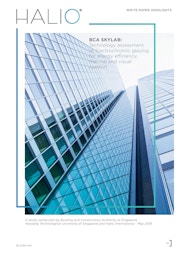
The Energy Research Institute at Nanyang Technological University (ERI@N) conducted a full-scale real-world laboratory test on Halio electrochromic glazing (EC) technology or known as smart-tinting glass at the BCA SkyLab in 2018. The test aimed to understand Halio’s impact on glare control, occupant comfort and energy consumption in comparison with traditional high-grade low-E coated glass and shut blinds, and was part of a larger study on air-conditioning systems and auto-dimming LED lights.
The test results showed that Halio’s EC technology, as a facade, outperformed traditional low-E coated glass with indoor blinds in three areas: avoiding glare, improving thermal comfort and achieving energy savings from lighting. The test benefitted from the advanced testing capabilities offered by SkyLab, such as its rotatable platform, integrated plug-n-play function, and its dual-chamber design with a test room and reference room for comparison testing.
Visual comfort: glare protection
The test showed that Halio eliminated 100 per cent of glare at the occupant’s viewing position and even in its darkest state, remained transparent to provide an undisrupted view of the outside environment. Conversely, the reference room with low-E double glazing and retracted blinds had shown three hours of intolerable glare and 1.25 hours of disturbing glare during office hours 9am to 6pm in a typical sunny day.
Such glare would prompt manual blinds to be lowered to combat the glare but typically are never raised again when the source of glare disappears. In fact, large offices in the tropics are usually fit with low-E glass and shut blinds, keeping out the view in many cases. EC technology now allows the benefits of visual comfort while keeping the natural view and daylight.
Thermal comfort: Keeping cool 24/7
The test room equipped with Halio delivered a comfortable thermal environment at 95 per cent of the time, compared to 75 per cent - 78 per cent for that with low-E double-glazed glass with retracted and closed blinds, respectively. While thermal comfort is usually maintained with low-e glass and shut blinds in the tropics, EC technology improves thermal comfort by reducing heat gain through tinting of the façade.
Energy Savings: Less need for artificial lighting, more energy savings potential
The room with Halio consumed 17 per cent to 25 per cent less energy from lighting in the West and North-facing, respectively, as compared to the room with the low-E double-glazed glass with closed blinds. As Halio can adjust to natural light situations in both excessive glare and gloomier weather, the smart-tinting windows provide occupants not only with more natural light, but also reduce the need for artificial lighting.
In this extensive laboratory study, Halio and traditional low-E coated glass with indoor blinds were installed in SkyLab’s two identical rooms next to each other. Each of the 43 square metre room was designed to mimic a typical office space, with each office fitted with four workstations and high-precision laboratory-grade sensors.
The testing facility was installed in the BCA SkyLab and mounted on a rotatable platform to test the facades in two orientations: North and West, which represent the majority of buildings in Singapore. Testing was conducted for two weeks in February 2018, out of which six days of similar weather conditions were selected to analyse from the two rooms include energy consumption, heat gain, weather, and comfort.
Buildings and building construction sectors account for 36 per cent of global energy consumption[1] while facades account for almost 50 per cent of the thermal loads in buildings in the tropics.[2] In Singapore, the building sector is responsible for more than one-third of the nation’s total electricity consumption with almost half of total energy usage attributed to office buildings. To address this, Singapore aims to green 80 per cent of its building stock by 2030 and reduce its emissions intensity by 36 per cent from 2005 levels by 2030.[3]
[1]Energy Efficiency: Buildings; The International Energy Agency, https://www.iea.org/topics/energyefficiency/buildings/
[2] Testing of building façade elements, including building-integrated PV systems (BIPV), Solar Energy Research Institute of Singapore, http://www.seris.sg/activities/Testing-of-building-elements.html
[3] Super Low Energy Building: Technology Roadmap, Building and Construction Authority, https://www.bca.gov.sg/GreenMark/others/SLE_Tech_Roadmap.pdf
Publish your content with EB Publishing
It's about who you reach. Get your news, events, jobs and thought leadership seen by those who matter to you.










